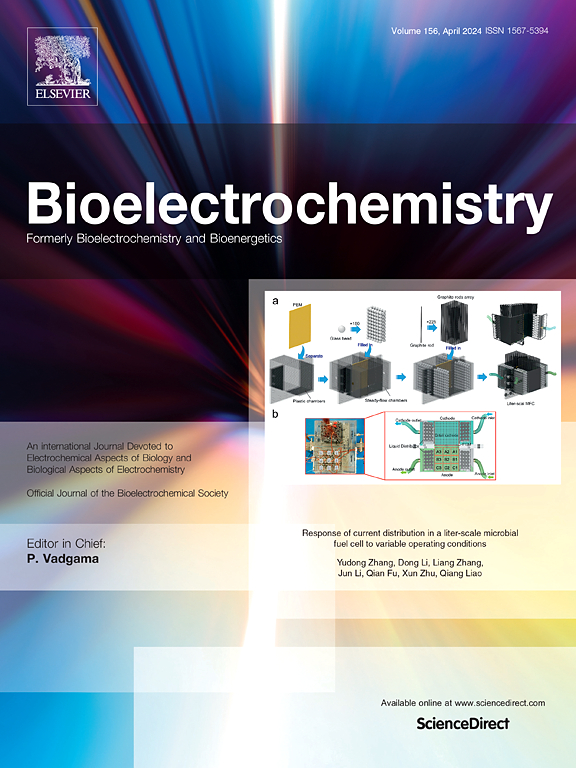亚稳液-液接触掺杂增强PEDOT: PSS墨水恒电位库仑法优化血清钙离子检测。
IF 4.8
2区 化学
Q1 BIOCHEMISTRY & MOLECULAR BIOLOGY
引用次数: 0
摘要
通过在Au电极上滴铸一层聚(3,4-乙烯二氧噻吩):聚苯乙烯磺酸盐(PEDOT: PSS)作为离子-电子转移层,制备了高度稳定的钙离子选择性电极(Ca2+-ISEs)。采用亚稳液-液接触(MLLC)掺杂法制备了导电PEDOT: PSS油墨,诱导相分离,去除多余的PSS,显著提高了电荷转移动力学和电导率。得到的Ca2+- ise具有优异的电化学性能。电位测定结果表明,该方法灵敏度为33.1±0.98 mV/decade (N = 3),电位稳定性为3.16±2.53 μV/h。重要的是,Ca2+-ISE结合恒电位库仑法,优化了下限检测限为8.527 × 10-8 M (LOD = 3σ/s, N = 3)。用恒电位库仑法对Ca2+-ISE系统在灭活胎牛血清中的性能进行了评估,与电位法和计时安培法相比,显示出最高的测量精度。本研究开发的基于PEDOT: PSS-MLLC的增强型Ca2+-ISEs结合恒电位库伦法,在血液离子分析中具有相当大的临床应用潜力。本文章由计算机程序翻译,如有差异,请以英文原文为准。

Optimized detection of calcium ion in serum using constant potential coulometry with metastable liquid–liquid contact doping enhanced PEDOT: PSS ink
Highly stable calcium ion selective electrodes (Ca2+-ISEs) were developed by drop-casting a layer of poly(3,4-ethylenedioxythiophene): polystyrene sulfonate (PEDOT: PSS) as an ion-to-electron transfer layer onto Au electrode. The conductive PEDOT: PSS ink was prepared using a metastable liquid–liquid contact (MLLC) doping method, which induced phase separation, removed excess PSS, and significantly enhanced charge transfer kinetics and conductivity. The resulting Ca2+-ISEs exhibited excellent electrochemical performance. Potentiometric studies revealed a significant sensitivity of 33.1 ± 0.98 mV/decade (N = 3) with a high potential stability of 3.16 ± 2.53 μV/h. Importantly, Ca2+-ISEs combined with the constant potential coulometry method, the lower detection limit was optimized to 8.527 × 10−8 M (LOD = 3σ/s, N = 3). The performance of the Ca2+-ISE system was evaluated in inactivated fetal bovine serum using constant potential coulometry, demonstrating the highest measurement accuracy compared to potentiometric and chronoamperometric. The enhanced PEDOT: PSS-MLLC based Ca2+-ISEs combined with the constant potential coulometry method developed in this research demonstrate considerable potential for clinical applications in blood ion analysis.
求助全文
通过发布文献求助,成功后即可免费获取论文全文。
去求助
来源期刊

Bioelectrochemistry
生物-电化学
CiteScore
9.10
自引率
6.00%
发文量
238
审稿时长
38 days
期刊介绍:
An International Journal Devoted to Electrochemical Aspects of Biology and Biological Aspects of Electrochemistry
Bioelectrochemistry is an international journal devoted to electrochemical principles in biology and biological aspects of electrochemistry. It publishes experimental and theoretical papers dealing with the electrochemical aspects of:
• Electrified interfaces (electric double layers, adsorption, electron transfer, protein electrochemistry, basic principles of biosensors, biosensor interfaces and bio-nanosensor design and construction.
• Electric and magnetic field effects (field-dependent processes, field interactions with molecules, intramolecular field effects, sensory systems for electric and magnetic fields, molecular and cellular mechanisms)
• Bioenergetics and signal transduction (energy conversion, photosynthetic and visual membranes)
• Biomembranes and model membranes (thermodynamics and mechanics, membrane transport, electroporation, fusion and insertion)
• Electrochemical applications in medicine and biotechnology (drug delivery and gene transfer to cells and tissues, iontophoresis, skin electroporation, injury and repair).
• Organization and use of arrays in-vitro and in-vivo, including as part of feedback control.
• Electrochemical interrogation of biofilms as generated by microorganisms and tissue reaction associated with medical implants.
 求助内容:
求助内容: 应助结果提醒方式:
应助结果提醒方式:


